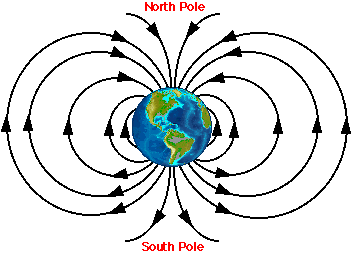
THE EARTH'S MAGNETIC FIELD

Several features of the Earth's field vary in a predictable way across the surface of the globe and might, in principle, be used in assessing geographic position. For example, at each location on the Earth, the field lines intersect the Earth's surface at a specific angle of inclination. On the diagram above, note that near the equator, the field lines are approximately parallel to the Earth's surface; the inclination angle in this region is said to be 0°. As one travels north from the equator, however, the field lines become progressively steeper. At the magnetic pole, the field lines are directed almost straight down into the Earth and the inclination is said to be 90°. Thus, inclination angle varies with latitude. As a consequence, an animal that has the ability to distinguish between magnetic inclination angles has a mechanism that it might be able to use to approximate its latitude. As we will discuss, hatchling loggerheads have been shown to have this ability.
A second geomagnetic parameter that varies across the surface of the Earth is the strength or intensity of the field. Although intensity varies somewhat less predictably than inclination, the general trend is that the field is strongest near the magnetic poles and is weakest near the equator. Hatchling loggerheads have also been shown to detect magnetic field intensity.
Important Features of the Earth's field: